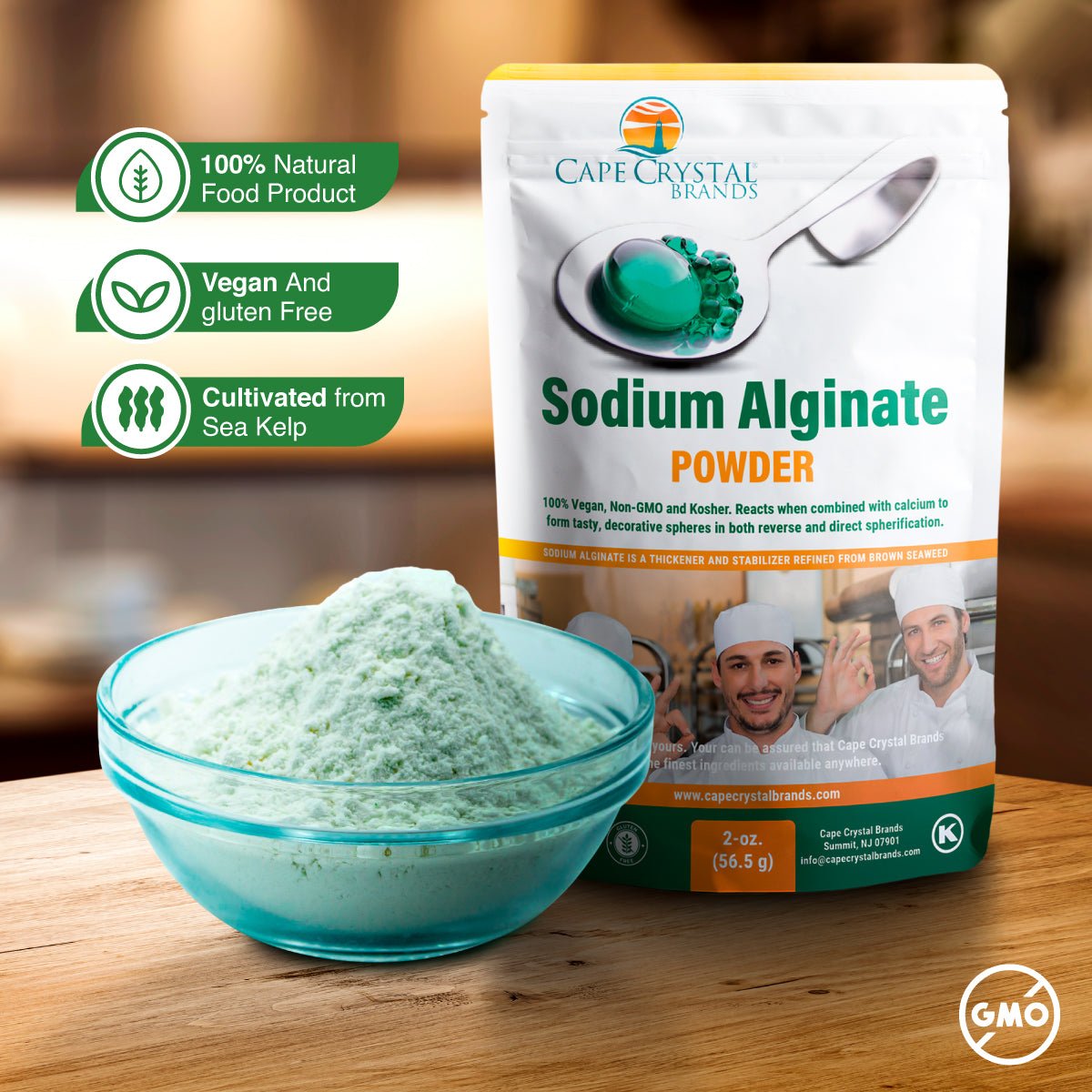Trending searches

Hydrocolloid: Sodium Alginate
SUBSCRIBE TO OUR BLOG
Promotions, new products, and recipes.
Sodium Alginate: The Seaweed Extract Revolutionizing the Food Industry
Sodium alginate, a natural extract from brown seaweed, has been making waves in the food industry for its unique properties. From thickening sauces to creating avant-garde culinary delights, this hydrocolloid has a myriad of applications. But what exactly is sodium alginate, and why has it become such a sought-after ingredient in both traditional and modern cuisines?
Origins and Historical Significance
Sodium alginate's journey began centuries ago, predominantly in Asian countries. It was traditionally used as a stabilizer and thickener in foods like noodles and certain desserts. However, it wasn't until the early 20th century that its commercial extraction began, paving the way for its widespread use in the food industry. Various companies and researchers recognized its potential, transitioning it from its traditional roots to a modern culinary powerhouse1.
The Science Behind Sodium Alginate
At its core, sodium alginate is a polysaccharide, composed of mannuronic (M) and guluronic (G) acid residues2. These residues are arranged in varying sequences, and the ratio between them plays a pivotal role in determining its functionality in food. When in the presence of calcium ions, sodium alginate undergoes a fascinating transformation, forming a heat-stable gel3. This property is especially harnessed in molecular gastronomy, a sub-discipline of food science that seeks to investigate the physical and chemical transformations of ingredients while cooking.
Extraction and Processing
The primary source of sodium alginate is brown seaweeds, especially species like Laminaria and Macrocystis4. Once harvested, these seaweeds undergo a meticulous extraction process. They are treated with an alkali solution, typically sodium carbonate, converting the insoluble alginate in the seaweed into its soluble sodium counterpart5. This solution is then purified, filtered, and precipitated to yield the final sodium alginate product.
Try Sodium Alginate Yourself
Pick up a packet of Cape Crystal Brands Sodium Alginate below. You will be glad you did.
A Multifaceted Ingredient
Sodium alginate's versatility is truly remarkable. In the food industry, it serves multiple purposes:
-
Thickening Agent: It can increase the viscosity of a liquid without significantly altering its other properties6.
-
Gelling Agent: Its interaction with calcium ions allows it to form stable gels, a property that's extensively used in creating gel-based desserts and in techniques like spherification7.
-
Stabilizer: Sodium alginate prevents the separation of ingredients in emulsions, ensuring products like dressings and ice creams maintain a consistent texture and appearance8.
-
Texture Enhancer: It can modify the mouthfeel of various food products, making them more palatable9.
Furthermore, sodium alginate's ability to work in tandem with other hydrocolloids, such as xanthan gum, allows for modifications in viscosity and gel strength, making it a favorite among food formulators10.
Global Suppliers and Production Hubs
With its rising popularity, the demand for sodium alginate has surged. Leading the supply chain are companies like FMC Corporation, KIMICA, Gelymar, and Cargill. Production is predominantly concentrated in regions abundant in brown seaweed, including the coasts of Norway, Canada, South America and Japan11.
Beyond the Culinary World
While the food industry remains a significant consumer of sodium alginate, its applications extend to other sectors. The textile industry, pharmaceuticals, and even dentistry utilize sodium alginate for its unique properties12.
Conclusion
Sodium alginate exemplifies how nature, combined with scientific understanding, can lead to innovations that enhance our culinary experiences. Its journey from traditional Asian kitchens to modern food labs underscores its versatility and enduring appeal. As research delves deeper into its potential, sodium alginate's role in the food industry is set to become even more pivotal, promising exciting culinary innovations for the future13.
For further reading:
Footnotes
-
Draget, K.I., et al. "Alginates from Algae." Biopolymers Online, 2005. ↩
-
Grant, G.T., et al. "Biological interactions between polysaccharides and divalent cations: The egg-box model." FEBS Letters, 1973. ↩
-
Lee, K.Y., & Mooney, D.J. "Alginate: Properties and biomedical applications." Progress in Polymer Science, 2012. ↩
-
McHugh, D.J. "A guide to the seaweed industry." FAO Fisheries Technical Paper, 2003. ↩
-
Penman, A., & Sanderson, G.R. "A method for the determination of uronic acid sequence in alginates." Carbohydrate Research, 1972. ↩
-
Morris, E.R., et al. "Gelation of carrageenan and alginate." Food Hydrocolloids, 1988. ↩
-
Adria, F., & Soler, J. "El Bulli: The taste of innovation." Harvard Business School, 2008. ↩
-
Falkeborg, M., et al. "Alginate oligosaccharides: enzymatic preparation and antioxidant property evaluation." Food Chemistry, 2014. ↩
-
Draget, K.I., et al. "Alginate based new materials." International Journal of Biological Macromolecules, 1997. ↩
-
Williams, P.A., & Phillips, G.O. "Introduction to food hydrocolloids." Handbook of Hydrocolloids, 2009. ↩
-
Bixler, H.J., & Porse, H. "A decade of change in the seaweed hydrocolloids industry." Journal of Applied Phycology, 2011. ↩
-
Rehm, B.H.A., & Valla, S. "Bacterial alginates: biosynthesis and applications." Applied Microbiology and Biotechnology, 1997. ↩
-
Draget, K.I., & Taylor, C. "Chemical, physical and biological properties of alginates and their biomedical implications." Food Hydrocolloids, 2011. ↩


|
About the Author Ed is the founder of Cape Crystal Brands, editor of the Beginner’s Guide to Hydrocolloids, and a passionate advocate for making food science accessible to all. Discover premium ingredients, expert resources, and free formulation tools at capecrystalbrands.com/tools. — Ed |
- Choosing a selection results in a full page refresh.



